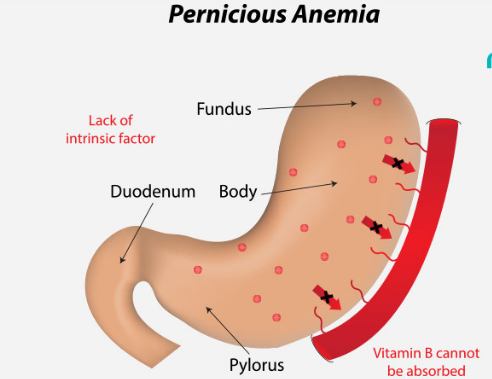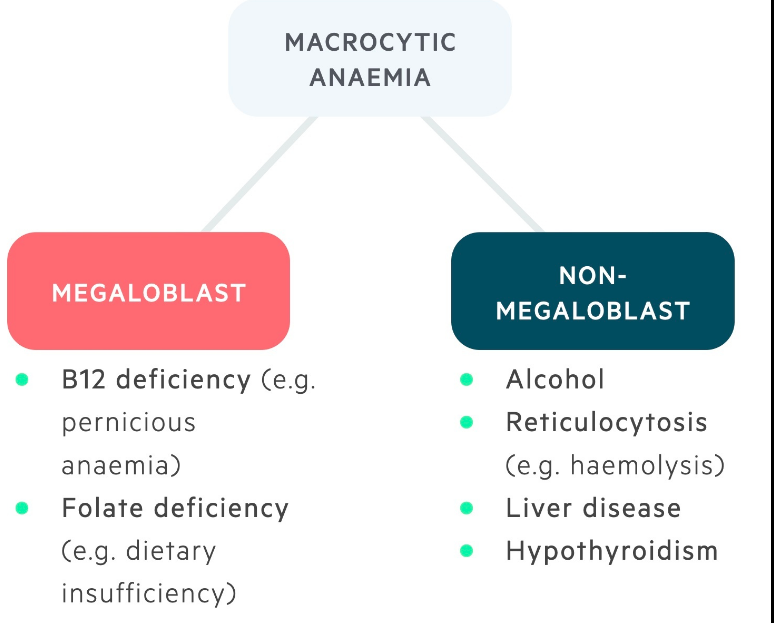Anemia is a prevalent health condition characterized by a deficiency in the number or quality of red blood cells, which are crucial for transporting oxygen throughout the body. While there are several types of anemia, megaloblastic and pernicious anemia stand out due to their distinct causes and implications on health. These forms of anemia are primarily related to the absorption and use of certain vitamins in the body, notably vitamin B12.
Megaloblastic anemia is mainly caused by a deficiency of vitamin B12 or folate, where the bone marrow produces unusually large, structurally abnormal, immature red blood cells. On the other hand, pernicious anemia is a specific type of megaloblastic anemia caused by the inability of the body to absorb vitamin B12 due to the lack of intrinsic factor—a protein secreted by the stomach that is vital for vitamin B12 absorption.
These conditions not only affect blood cell production but also have a significant impact on the body’s overall functioning and health. Early diagnosis and treatment are essential for managing their effects and preventing complications, highlighting the importance of understanding their differences and similarities.

Basics of Anemia
Definition and Importance
Anemia is a medical condition defined by a deficiency in the number or quality of red blood cells (RBCs) or a reduction in the quantity of hemoglobin, an essential protein in red blood cells that carries oxygen to the body’s tissues. This decrease in oxygen delivery can lead to various symptoms and affect overall health and wellbeing.
Importance of understanding anemia lies in its commonality and impact. Anemia affects millions globally and can contribute to a host of complications if left untreated, including severe fatigue, heart problems, and complications during pregnancy.
Common Symptoms
The symptoms of anemia can vary depending on the type, cause, and severity, but some common signs include:
- Fatigue and weakness
- Pale or yellowish skin
- Irregular heartbeats
- Shortness of breath
- Dizziness or lightheadedness
- Chest pain
- Cold hands and feet
- Headaches
What is Megaloblastic Anemia?
Definition and Causes
Megaloblastic anemia is a type of anemia characterized by the production of abnormally large red blood cells which are fewer in number and structurally flawed due to improper DNA synthesis. This condition is most commonly caused by deficiencies in vitamin B12 or folate. These nutrients are crucial for proper red blood cell formation, and their lack can disrupt this process.
Key Symptoms
Key symptoms of megaloblastic anemia include:
- Severe fatigue and weakness
- Pale or yellowish skin
- Mouth ulcers
- Visual disturbances
- Mental confusion or forgetfulness
- Difficulty walking or muscle weakness
What is Pernicious Anemia?
Definition and Causes
Pernicious anemia is a specific type of megaloblastic anemia caused by the inability of the body to absorb vitamin B12 due to the lack of intrinsic factor. This protein, produced by the stomach lining, is vital for the absorption of vitamin B12. The absence of intrinsic factor, often due to an autoimmune response, leads to vitamin B12 deficiency and subsequently to pernicious anemia.
Key Symptoms
The symptoms of pernicious anemia overlap with general B12 deficiency but often include:
- Memory loss and cognitive changes
- Balance and coordination problems
- Numbness or tingling in the hands and feet
- Swollen, red tongue or bleeding gums
Comparing Pathophysiology
Bone Marrow Changes
The bone marrow in both megaloblastic and pernicious anemia undergoes significant changes that can be observed under a microscope:
- Megaloblastic anemia: The marrow is usually hyperactive but inefficient. It produces large, immature, structurally abnormal red blood cells known as megaloblasts.
- Pernicious anemia: Similar changes are noted, but these are directly linked to the chronic absence of vitamin B12 due to the lack of intrinsic factor.
Blood Cell Morphology
Examining the morphology of blood cells provides insights into these conditions:
- Red Blood Cells: In both conditions, cells are larger than normal (macrocytic), but in pernicious anemia, they are also more likely to be oval-shaped.
- White Blood Cells and Platelets: These can also be affected, often appearing large and immature, especially in cases of severe deficiency.
Diagnostic Approaches
Blood Tests
Diagnosing anemia typically begins with a series of blood tests that can reveal much about the type and severity of the anemia. These tests include:
- Complete Blood Count (CBC): This test measures the number of blood cells, including red blood cells, white blood cells, and platelets. For megaloblastic and pernicious anemia, it shows large, immature red blood cells, indicating macrocytosis.
- Vitamin B12 and Folate Levels: Specifically measuring these levels can help determine the cause of megaloblastic anemia. Low levels of either nutrient are a clear indicator.
- Methylmalonic Acid (MMA): High levels of MMA can indicate a vitamin B12 deficiency, particularly useful in diagnosing pernicious anemia.
Bone Marrow Examination
In more ambiguous cases, a bone marrow examination may be necessary. This procedure involves:
- Aspiration and Biopsy: A small amount of bone marrow is extracted, usually from the hip bone, and analyzed.
- Morphological Evaluation: This analysis helps to identify abnormal marrow cells and can confirm the presence of megaloblastic changes due to folate or vitamin B12 deficiencies.
Treatment Strategies
Megaloblastic Anemia Treatment
Treatment for megaloblastic anemia focuses on correcting the nutrient deficiencies:
- Vitamin Supplementation: Oral folic acid and vitamin B12 supplements are administered to replenish body stores.
- Dietary Changes: Increasing intake of folate-rich foods like leafy greens, nuts, and beans, as well as foods rich in vitamin B12, such as eggs, dairy, and meat.
Pernicious Anemia Treatment
Pernicious anemia requires lifelong treatment due to its nature:
- Vitamin B12 Injections: Initially, high doses are given frequently to rapidly replenish body stores. Over time, the frequency may decrease based on the patient’s response.
- Oral B12 Supplements: High-dose oral B12 may be used as a maintenance therapy after stabilization.
Impact on Health
Long-term Effects
Untreated or poorly managed anemia can lead to severe health complications, such as:
- Heart Problems: Strain and heart failure due to overworking to pump oxygen.
- Neurological Damage: In cases of B12 deficiency, significant nerve damage can occur, potentially leading to mobility and cognitive issues.
Quality of Life
The impact on quality of life can be profound:
- Daily Fatigue: This can interfere with work and social life.
- Cognitive Impairment: Reduced mental clarity and forgetfulness can affect personal and professional life.
Preventive Measures
Diet and Supplements
Preventing these types of anemia involves adequate intake of key nutrients:
- Folate: Include foods like spinach, asparagus, and Brussels sprouts.
- Vitamin B12: Ensure sufficient intake through meat, eggs, and dairy, or consider supplements if you follow a vegan diet.
Regular Screening
For those at risk or with a family history of anemia, regular screening is crucial:
- Annual Blood Tests: These can help catch anemia early before symptoms worsen.
- Physician Consultation: Regular check-ups can help tailor prevention strategies effectively.
Frequently Asked Questions
What causes Megaloblastic Anemia?
Megaloblastic anemia primarily results from deficiencies in folate or vitamin B12. These deficiencies lead to the production of larger than normal red blood cells that are unable to function properly, disrupting oxygen transport throughout the body.
What causes Pernicious Anemia?
Pernicious anemia is caused by the body’s inability to absorb vitamin B12 due to the absence or malfunctioning of intrinsic factor. This condition is often associated with an autoimmune response that damages the stomach lining where intrinsic factor is produced.
How is Megaloblastic Anemia diagnosed?
Diagnosis of megaloblastic anemia involves blood tests to measure levels of vitamin B12, folate, and complete blood count, which often shows large red blood cells. Bone marrow examination may also be conducted to further assess the nature of the anemia.
How is Pernicious Anemia treated?
Treatment for pernicious anemia generally involves high doses of vitamin B12, usually administered through injections or high-dose oral supplements. This treatment is often lifelong to manage symptoms and prevent neurological complications.
Can diet affect these types of Anemia?
Yes, diet plays a crucial role in managing and preventing both megaloblastic and pernicious anemia. Ensuring a diet rich in vitamin B12 and folate can help prevent megaloblastic anemia, while dietary adjustments alone may not be sufficient for those with pernicious anemia due to absorption issues.
Conclusion
Megaloblastic and pernicious anemia are significant health concerns that, while related, require distinct approaches for diagnosis and management. Understanding the nuances between these conditions empowers individuals to seek timely medical advice and appropriate treatment. Awareness and knowledge about these types of anemia are critical in maintaining overall health and preventing the severe consequences associated with untreated anemia.
Proper management of these conditions involves more than just treatment—it’s also about lifestyle adjustments and regular monitoring. Ultimately, early detection and proactive management are key to effectively controlling the impact of these anemias on daily life, making comprehensive medical guidance indispensable.

